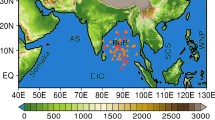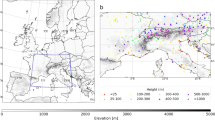Abstract
The cause of asymmetric atmospheric circulation responses over the tropical western North Pacific (WNP) to El Niño and La Niña was investigated through observational analyses and idealized modeling experiments. Firstly, column integrated moisture and moist static energy budget analyses were carried out to reveal the cause of asymmetric precipitation anomalies over the WNP. The result indicates that negative nonlinear moist enthalpy advection anomalies occur in both El Niño and La Niña, and they tend to induce a negative precipitation anomaly in the key WNP region and thus an anomalous anticyclone during both El Niño and La Niña winters. This, together with linear moist enthalpy advection, results in an asymmetric atmospheric circulation response. Secondly, the relative roles of the nonlinear moist enthalpy advection and the zonal shift of longitudinal location of anomalous heating over the central-eastern Pacific between El Niño and La Niña were investigated through an anomaly general circulation model. It is found that both the nonlinear advection and the zonally asymmetric heating contribute equally to the observed zonal shift of the anomalous WNP anticyclonic and cyclonic circulation centers between El Niño and La Niña.













Similar content being viewed by others
References
Adler RF et al (2003) The version-2 global precipitation climatology project (GPCP) monthly precipitation analysis (1979-present). J Hydrometeorol 4:1147–1167
Chang CP, Zhang YS, Li T (2000a) Interannual and interdecadal variations of the East Asian summer monsoon and tropical Pacific SSTs. Part I: roles of the subtropical ridge. J Clim 13:4310–4325
Chang CP, Zhang YS, Li T (2000b) Interannual and interdecadal variations of the East Asian summer monsoon and tropical Pacific SSTs. Part II: meridional structure of the monsoon. J Clim 13:4326–4340
Chen MC, Li T, Shen XY, Wu B (2016) Relative roles of dynamic and thermodynamic processes in causing evolution asymmetry between El Niño and La Niña. J Clim 29:2201–2220
Dee DP, Uppala SM, Simmons AJ (2011) The ERA-Interim reanalysis: configuration and performance of the data assimilation system. Q J R Meteorol Soc 137:553–597
Gill AE (1980) Some simple solutions for heat-induced tropical circulation. Quart J Roy Meteor Soc 106:447–462
He C, Zhou T, Wu B (2015) The key oceanic regions responsible for the interannual variability of the western North Pacific subtropical high and associated mechanisms. J Meteorol Res 29:562–575. https://doi.org/10.1007/s13351-015-5037-3
Held IM, Suarez MJ (1994) A proposal for the intercomparison of the dynamical cores of atmospheric general circulation models. Bull Am Meteorol Soc 75:1825–1830
Hoerling M, Kumar A, Zhong M (1997) El Niño, La Niña, and the nonlinearity of their teleconnections. J Clim 10:1769–1786
Jiang XA, Li T (2005) Reinitiation of the boreal summer intraseasonal oscillation in the tropical Indian Ocean. J Clim 18:3777–3795
Li T, Hsu PC (2017) Fundamentals of tropical climate dynamics, text book. Springer, Berlin (978-3-319-59595-6)
Li T, Wang B (2005) A review on the western North Pacific monsoon: synoptic-to-inter annual variabilities. Terr Atmos Ocean Sci 16:285–314
Li T, Liu P, Fu X, Wang B (2006) Spatiotemporal structures and mechanisms of the tropospheric biennial oscillation in the Indo-Pacific warm ocean regions. J Clim 19:3070–3087
Li T, Wang B, Wu B, Zhou TJ, Chang CP, Zhang RH (2017) Theories on formation of an anomalous anticyclone in western North Pacific during El Niño: a review. J Meteorol Res 31:987–1006
Neelin JD (2007) Moist dynamics of tropical convection zones in monsoons, teleconnections, and global warming. In: Schnei-der T, Sobel A (eds) The global circulation of the atmosphere. Princeton University Press, Princeton, pp 267–301
Neelin JD, Held IM (1987) Modeling tropical convergence based on the moist static energy budget. Mon Weather Rev 115:3–12
Rayner NA, Parker DE, Horton EB et al (2003) Global analyses of sea surface temperature, sea ice, and night marine air temperature since the late nineteenth century. J Geophys Res 108:4407
Su JZ, Zhang RH, Li T et al (2010) Causes of the El Niño and La Niña amplitude asymmetry in the equatorial eastern Pacific. J Clim 23:605–617
Tao WC, Huang G, Wu RG, Hu KM, Wang PF (2017) Asymmetry in summertime atmospheric circulation anomalies over the northwest Pacific during decaying phase of El Niño and La Niña. Clim Dyn 49:2007–2023
Wang B, Wu RG, Fu XH (2000) Pacific-East Asian teleconnection: how does ENSO affect East Asian climate? J Clim 13:1517–1536
Wang B, Wu RG, Li T (2003) Atmosphere-warm ocean interaction and its impacts on Asian–Australian monsoon variation. J Clim 16:1195–1211
Wu B, Li T, Zhou TJ (2010) Asymmetry of atmospheric circulation anomalies over the western North Pacific between El Niño and La Niña. J Clim 23:4807–4822
Wu B, Zhou TJ, Li T (2017a) Atmospheric dynamic and thermodynamic processes driving the western North Pacific anomalous anticyclone during El Niño. Part I: Maintenance mechanisms. J Clim 30:9621–9635
Wu B, Zhou TJ, Li T (2017b) Atmospheric dynamic and thermodynamic processes driving the western North Pacific anomalous anticyclone during El Niño. Part II: Formation processes. J Clim 30:9637–9650
Xie SP, Kosaka Y, Du Y, Hu K, Chowdary JS, Huang G (2016) Indo-western Pacific ocean capacitor and coherent climate anomalies in post-ENSO summer: a review. Adv Atmos Sci 33:411–432. https://doi.org/10.1007/s00376-015-5192-6
Zhang RH, Sumi A, Kimoto M (1996) Impact of El Niño on the East Asian monsoon: a diagnostic study of the ’86/87 and ’91/92 events. J Meteorol Soc Jpn 74:49–62
Zhang RH, Min QY, Su JZ (2017) Impact of El Niño on atmospheric circulations over East Asia and rainfall in China: role of the anomalous western North Pacific anticyclone. Sci China Earth Sci 60:1124–1132. https://doi.org/10.1007/s11430-016-9026-x
Acknowledgements
This work was supported by NSFC key project 41630423, National Basic Research Program 2015CB453200, NSF Grant AGS-1565653, NOAA Grant NA18OAR4310298, and NSFC Grant 41875069. This is SOEST contribution number 10679, IPRC contribution number 1374, and ESMC contribution number 257.
Author information
Authors and Affiliations
Corresponding author
Additional information
Publisher's Note
Springer Nature remains neutral with regard to jurisdictional claims in published maps and institutional affiliations.
Rights and permissions
About this article
Cite this article
Wang, X., Li, T. & Chen, M. Mechanism for asymmetric atmospheric responses in the western North Pacific to El Niño and La Niña. Clim Dyn 53, 3957–3969 (2019). https://doi.org/10.1007/s00382-019-04767-4
Received:
Accepted:
Published:
Issue Date:
DOI: https://doi.org/10.1007/s00382-019-04767-4




